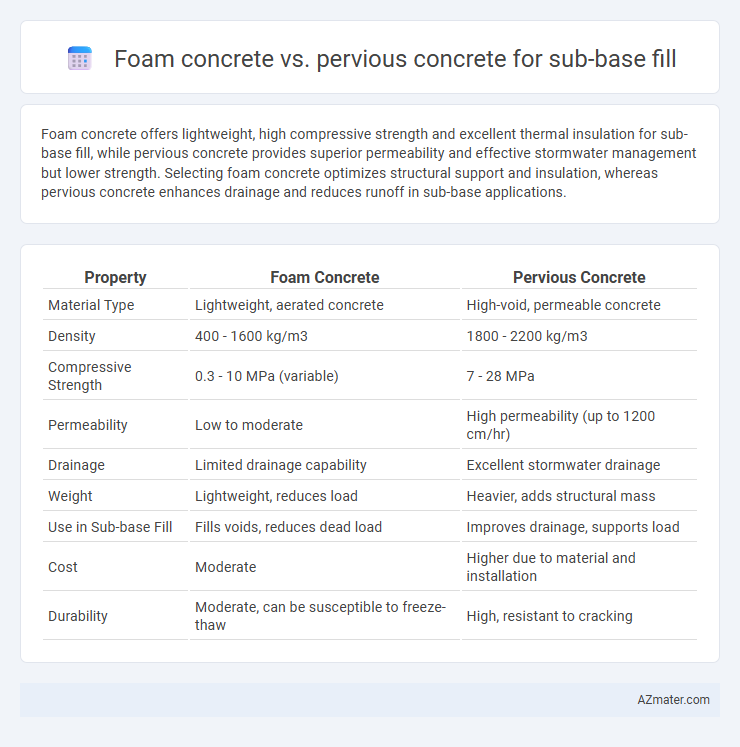Foam concrete offers lightweight, high compressive strength and excellent thermal insulation for sub-base fill, while pervious concrete provides superior permeability and effective stormwater management but lower strength. Selecting foam concrete optimizes structural support and insulation, whereas pervious concrete enhances drainage and reduces runoff in sub-base applications.
Table of Comparison
| Property | Foam Concrete | Pervious Concrete |
|---|---|---|
| Material Type | Lightweight, aerated concrete | High-void, permeable concrete |
| Density | 400 - 1600 kg/m3 | 1800 - 2200 kg/m3 |
| Compressive Strength | 0.3 - 10 MPa (variable) | 7 - 28 MPa |
| Permeability | Low to moderate | High permeability (up to 1200 cm/hr) |
| Drainage | Limited drainage capability | Excellent stormwater drainage |
| Weight | Lightweight, reduces load | Heavier, adds structural mass |
| Use in Sub-base Fill | Fills voids, reduces dead load | Improves drainage, supports load |
| Cost | Moderate | Higher due to material and installation |
| Durability | Moderate, can be susceptible to freeze-thaw | High, resistant to cracking |
Introduction to Sub-base Fill Materials
Foam concrete offers lightweight, high flowability, and excellent thermal insulation properties, making it ideal for sub-base fill in road construction and void filling applications. Pervious concrete provides superior drainage and permeability, allowing water to pass through, reducing surface runoff and improving stormwater management in sub-base layers. Selecting between foam concrete and pervious concrete depends on load-bearing requirements, drainage needs, and environmental conditions at the construction site.
What is Foam Concrete?
Foam concrete is a lightweight, aerated material composed of cement, water, and a stable foam that creates numerous tiny air bubbles, resulting in low density and high thermal insulation. This sub-base fill material offers excellent flowability, easy placement, and rapid setting, reducing labor and construction time in comparison to traditional fills. Its compressive strength and durability make foam concrete ideal for reducing load on underlying soil while providing effective drainage and insulation properties in foundation and road base applications.
What is Pervious Concrete?
Pervious concrete is a highly porous material designed to allow water to pass through, making it ideal for sub-base fill in applications requiring enhanced drainage and groundwater recharge. Unlike foam concrete, which emphasizes lightweight properties and compressive strength, pervious concrete prioritizes permeability and stormwater management by incorporating a network of interconnected voids. This characteristic reduces surface runoff and mitigates flooding risks, positioning pervious concrete as a sustainable solution for permeable pavements and environmentally friendly infrastructure projects.
Material Composition and Properties
Foam concrete consists of cement, water, and stable air bubbles introduced via a foaming agent, resulting in a lightweight, low-density material with high thermal insulation and good flowability. Pervious concrete incorporates coarse aggregates, cement, water, and minimal fines to create a porous structure that allows water permeability and enhanced drainage. Compared to foam concrete, pervious concrete offers higher compressive strength and superior permeability, while foam concrete provides better insulation and reduced weight for sub-base fill applications.
Structural Performance Comparison
Foam concrete offers superior compressive strength ranging from 3 to 8 MPa, providing excellent load-bearing capacity for sub-base fill applications compared to pervious concrete, which typically exhibits lower strength around 2 to 5 MPa due to its high porosity. The closed-cell structure of foam concrete ensures reduced permeability and greater durability under cyclic loading, whereas pervious concrete's open-graded pore structure allows for enhanced drainage but compromises long-term structural integrity. For sub-base fill, foam concrete demonstrates better resistance to settlement and deformation, making it a more reliable choice in heavy traffic and high-load environments.
Permeability and Drainage Capabilities
Foam concrete exhibits lower permeability compared to pervious concrete, making it less effective for drainage applications in sub-base fills where water flow is critical. Pervious concrete features a highly porous structure that allows rapid water infiltration, significantly enhancing drainage capabilities and reducing runoff. For sub-base fill requiring superior permeability and efficient water management, pervious concrete is the preferred choice due to its optimized void content and hydraulic conductivity.
Installation and Workability
Foam concrete offers superior workability for sub-base fill due to its lightweight, flowable consistency, allowing easy pumping and placement even in confined spaces. Its low density and high air content reduce compaction needs, accelerating installation and minimizing equipment usage. Pervious concrete, while permeable and structurally strong, requires careful mix design and meticulous placement to maintain porosity, making its installation more labor-intensive and slower compared to foam concrete.
Environmental Impact and Sustainability
Foam concrete offers enhanced sustainability with its lightweight properties, lower cement content, and improved insulation, leading to reduced carbon emissions during production compared to traditional concrete. Pervious concrete significantly improves environmental outcomes by promoting groundwater recharge and reducing stormwater runoff, thus mitigating urban flooding and enhancing water quality. Both materials provide eco-friendly sub-base solutions but differ in environmental impact emphasis: foam concrete focuses on resource efficiency and carbon footprint reduction, while pervious concrete targets hydrological benefits and urban sustainability.
Cost Analysis: Foam vs. Pervious Concrete
Foam concrete generally offers a lower cost per cubic meter compared to pervious concrete due to reduced material density and the utilization of lightweight aggregates and foam agents. Pervious concrete requires higher maintenance and often entails additional drainage system costs, increasing total expenditure over time. The initial savings of foam concrete make it a cost-effective option for sub-base fill, especially in large-scale infrastructure projects where budget constraints are critical.
Best Applications and Recommendations
Foam concrete, known for its lightweight properties and excellent thermal insulation, is best suited for sub-base fill in areas requiring reduced load on underlying soils, such as road embankments and roof insulation. Pervious concrete excels in applications demanding superior drainage capabilities, making it ideal for sustainable urban drainage systems, parking lot bases, and sidewalks where stormwater management is critical. For optimal performance, utilize foam concrete in sites prone to expansive soils or where ground improvement is necessary, while pervious concrete should be recommended in environments focused on reducing runoff and enhancing groundwater recharge.

Infographic: Foam concrete vs Pervious concrete for Sub-base fill
 azmater.com
azmater.com